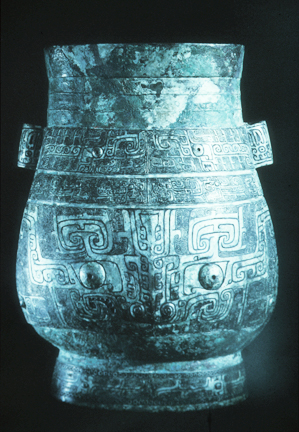Once thought to be merely mythological or legendary, archaeological evidence now shows that the Shang Dynasty (1700-1100 BCE) did actually exist. Shang rulers occupied a series of capitals in the Yellow River valley that had walled perimeters, royal palaces, and vast royal tombs. These tombs reveal a warrior culture with human and animal sacrifices to accompany the deceased in burial. Entire teams of skeletal remains of horses and charioteers have been found in some royal Shang burials. These tombs also contained riches of bronze vessels, such as this example, as well as gold, jade, ivory, and silver, attesting to the wealth and power of these rulers. In the following Zhou dynasty (1100-21 BCE) Confucius proposed a system of thought that featured reverence for one's elders and traditions. He also condemned this practice of human sacrifice in royal burials, and gradually the custom did cease.
Bronze is an alloy composed of copper and tin. It is harder than copper, yet more readily melted. It is also harder than iron, and less susceptible to corrosion, making it an excellent material for melting and casting. Bronze vessels were used as containers for ritual offerings of food and wine and came in approximately 30 basic shapes. This particular shape, the hu, is one that we will inspire later Chinese potters, especially in the Song Dynasty.

Shang Bronze Hu,
China, 1300-1200 BCE, 12.25" height


